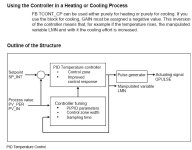I have an application that requires a Digital output to control an electric heater using PID Does anyone know of any information on digital PID loops..... I have done PID loops in the past but using an analog control signal which is easy, I am just not sure on exactly how to setup the digital output. My thoughts have been to take the digital output and two variable timers to give the output an ON/OFF time in the same fashion of a PWM output But ony controlling the duty cycle and leaving the Frequency constant. I would love to hear any Ideas anyone has. My customer is using a Omega SRFG Series Flexible Silicone Rubber Heater to control the temperature of a liquid and is looking to maintain that temperature between a range of 150-190 degrees C.
Thank you,
Dave
Thank you,
Dave





